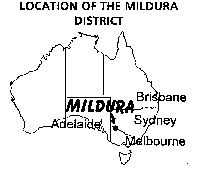The PIPE ORGAN at St Margaret's
 Greetings from the Anglican Parish of Northern Mallee, based at Mildura, Vic, Australia |
 |

St Margaret's Pipe Organ
 The note action consists of two stages.
The note action consists of two stages.The first is an electro magnetic valve which we know as a "Chest Magnet". When a stop is "On" and a key of the same manual is depressed a contact is made through the stop switch in the console to the chest magnet in the organ. The magnet then opens the sprung valve disc and allows the air in the Diaphragm to escape. This collapses the diaphragm, taking with it the Pipe valve under the pipe hole. The second stage occurs when the note key is released. The pressurised air in the windchest flows in to the magnet cavity and up into the diaphragm, re-inflating it and pushing the pipe valve against the pipe hole. The sound emerges, with the escaping air. Trouble arises if a small speck of dirt may settle between the sprung valve and its brass ferule seating, allowing the air to escape and thus cause the diaphragm to collapse and the note to be 'stuck' on.
First problem - the pipes themselves should never be touched or they will almost certainly be put out of tune. Stephen was told in 1997 that bottom C of the Octave 4' was cyphering, that is, stuck on. He says 'from the above information, you will see that the magnet concerned is the end one on the left of the front row, when viewed from inside the organ loft'. Packing instructions are very precise. It appears that the pipes were sent to Mr Laurie to be overhauled, and then Mr Laurie and his assistant returned with the pipes and spent days restoring them in position, re-regulating and fine-tuning, and inspecting the blower and console. We got a lot of service for the $2500 cost of the service. Mr Laurie comments 'most of the pipes have their note written or stamped either halfway up the pipe, or at the back behind the mouth.' Jim was instructed to remove the pipes from the organ and pack them, wrapping each pipe in newspaper, and placing the heaviest pipes in the bottom of the dispatch box.
The following paragraph gives more details of the construction of the pipes.
'To save space the largest of the Diapason pipes could be telescoped. It is very important that the ears of the wrapped inner pipe are used to prevent it sliding right inside the outer one, and that the ears and mouth of the inner one are protected with several layers of newspaper to make a snug fit. Pipes without ears must not be telescoped but should be wrapped in pairs,
|
|
|
my Australian Family History remembering over 430 pioneer families of Victoria Sultanas in Sunraysia and coding pages and Barrie, our Family Poet. This site is http://www.oocities.org/Mallee2001. Say Thanks to |
 St Margaret's Church
St Margaret's Church

 Third problem - removing the dust.
Third problem - removing the dust.  end for end with mouths facing inwards and layers of paper between them.
The very small pipes can be packed in groups of 4 or 6.'
end for end with mouths facing inwards and layers of paper between them.
The very small pipes can be packed in groups of 4 or 6.'